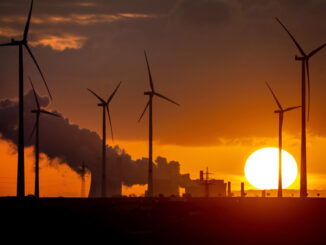
Authored by Naveen Athrappully via The Epoch Times (emphasis ours),
Wind power has been historically and scientifically unreliable, claims an Oxford University mathematician and physicist, with his calculations revealing the government to be pursuing a “bluster of windfarm politics” while discarding numerical evidence.
A wind farm outside of Palm Springs, Calif., on May 26, 2018. (John Fredricks/The Epoch Times)
After the decision to cut down on fossil fuels was made at the 2015 United Nations Climate Change Conference in Paris, the “instinctive reaction” around the world was to embrace renewables, Professor Emeritus Wade Allison, who is also a researcher at CERN, said in a 2023 paper (pdf).
Allison noted that because solar power is “extremely weak,” it was inadequate to “sustain even a small global population with an acceptable standard of living” before the Industrial Revolution.
“Today, modern technology is deployed to harvest these weak sources of energy. Vast ‘farms’ that monopolise the natural environment are built, to the detriment of other creatures. Developments are made regardless of the damage wrought. Hydro-electric schemes, enormous turbines and square miles of solar panels are constructed, despite being unreliable and ineffective; even unnecessary,” Allison said in the report, published by the Global Warming Policy Foundation.
“In particular, the generation of electricity by wind tells a disappointing story. The political enthusiasm and the investor hype are not supported by the evidence, even for offshore wind, which can be deployed out of sight of the infamous My Back Yard,” he wrote. “What does such evidence actually say?”
According to the U.S. Department of Energy, wind power generated more than 9 percent of the net total of the country’s energy in 2021 and is the largest source of renewable power in the country. Over 70,000 turbines generate enough power to serve the equivalent of 43 million American homes, the department says.
There are 120,000 jobs related to wind energy in the United States, the Energy Department says, and it’s one of the fastest-growing jobs in the country.
Allison explained that wind energy is measured based on the amount of moving air and the speed of the air as it reaches the area swept by the turbine blades.
The scientist calculated that, at 100 percent efficiency, if the wind blows at 10 meters per second (about 22 mph), the power is 600 watts per square meter. Hence, to deliver 3,200 million watts, the same output as Hinkley Point C–a planned zero-carbon nuclear power station in England–there would need to be 5.5 million square meters of turbine swept area.
“That should be quite unacceptable to those who care about birds and to other environmentalists,” Allison wrote.
The actual performance of the technology is much worse than the calculations made based on 100 percent efficiency, he said.
“Because the power carried by the wind depends on the third power of the wind speed, if the wind drops to half speed, the power available drops by a factor of 8,” he said. “Almost worse, if the wind speed doubles, the power delivered goes up 8 times, and as a result the turbine has to be turned off for its own protection.”
Read more here…
Loading…



